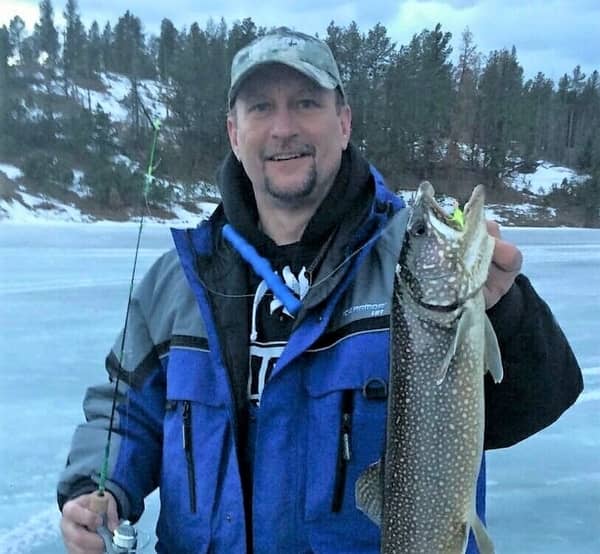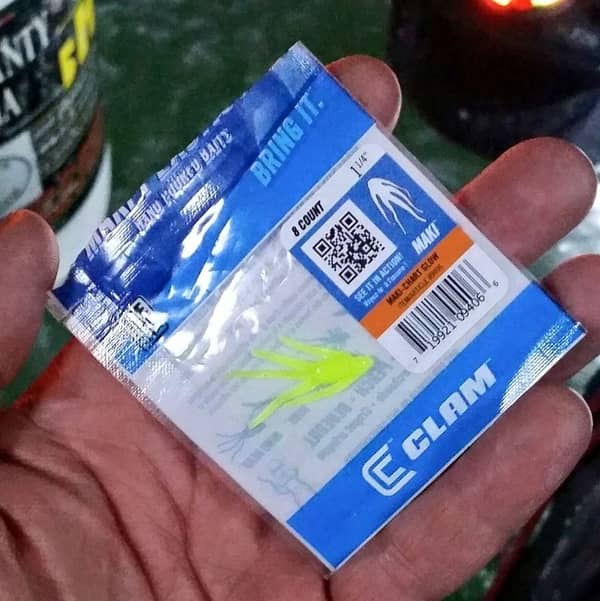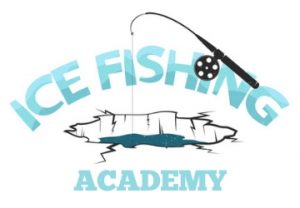There is a tiny little plastic bait that is so versatile, and it will land large trophy fish and small panfish! As more fishermen learn about microplastic fishing baits, the word is finally getting out.
Soft micro plastic ice fishing baits generally range in length from 1/2″ to 2″. Most micro baits replicate a type of zooplankton that fish feed on. Microplastics imitate scuds, bloodworms, insects, and shrimp. The ability to hook and pinch them in different ways increases their versatility.
Ice fishing baits, jigs, and lures have remained pretty close to the same designs for dozens of years and have put fish on the ice without fail.
Microplastics can be your secret weapon for ease of use and their proficiency at catching fish, even in a negative bite!
I’ve used these tiny plastic baits for many ice seasons, and they are consistent fish-catching baits.
Let’s dive in here and learn how to use them to increase your catch rate!
What Are Soft Micro Plastic Baits
As a general rule, you’ll find the plastics tiny imitator baits, with the higher quality baits having fantastic finesse action. I believe hand-poured microplastics have far better action than their mass-produced counterparts.
- Microplastic baits can be as tiny as a few millimeters in length or around two inches for larger baits. And depending upon what the particular type of bait is imitating, the bait’s body can be either thick or thin.
- Microplastic baits imitate zooplankton, shrimp, scuds, bloodworms, leeches, etc., found in or near waters. Some versions imitate ants and other small bugs.
- Microplastics can be purchased in many different colors. My favorite colors are white, yellow, chartreuse, and motor oil baits.
- Microplastic baits are convenient to carry in your pockets and store away nicely when not needed or being used. (This is a huge advantage over live minnows and other live baits that need fresh water or refrigeration!)
- Bait presentations can be modified to suit your ice fishing conditions and whether the fish are in an aggressive, passive, or negative bite mood.
How To Hook Micro Plastics for Ice Fishing
Hooking microplastic baits using different techniques can elicit several bait actions while fishing.
Successful ways include hooking lightly through the tip, threading directly onto the hook, vertically covering the hook barb, or stacking two or more onto the hook shank for a larger bait offering.
When first arriving on the ice, my initial go-to is to thread the microplastic completely onto the hook shank. Drop it down the fishing hole and seek out aggressive feeders!
If you see fish interested but not taking your offering when using a fish finder, I’ll change the setup and hook it lightly through the tip for a finesse presentation for those passive negative feeders.
Pro Tip: Carry a small tube of superglue with you. Place a drop of super glue where the plastic meets the hook to keep it from being torn off or lost when setting the hook. You can also fix torn areas too.
Stacking two or more microplastics in different colors can trigger an awesome panfish or walleye bite for a larger presentation.
- A popular and killer plastic to enhance your micro presentations is the Neki from Makiplastic (Take a look at it on Amazon!), It slides up the hook shank against the jig head and has about a dozen tentacles to entice those negative-biting fish!
How To Ice Fish With Micro Plastics
The classic bait presentation is with a light jigging motion that works well for most fish. As the fish moods change, presentations need to change.
Deadstick microplastics for passive fish and pound aggressively in place for active ones. Fish them just above vegetation or structure where what they imitate live.
A fellow I’ve shared the ice with on numerous occasions and who will sit on a 5-gallon bucket next to you to visit and share his fishing knowledge is Scott Brauer of Makiplastic.
This 5:52-minute video is a knowledge dump on fishing microplastics. It would take you many seasons to flesh out what Scott has learned over the years, and he shares it with you in just a few minutes.
“Maki Plastics designer Scott Brauer continues to study every insect in the water column to create life like shapes. His “match the hatch” concept of plastic bait development means one thing… you are going to catch more panfish with Maki plastics!”
What Is an Ice Jig
An ice jig comprises a small fishing hook with a solid head of varying shapes and sizes just behind the hook’s eye.
The jig head is made from lead, but more recently, they have been made from tungsten. Ice jigs are often tipped with live or artificial baits and are available in many weights and sizes.
You can find ice jigs for both horizontal and vertical presentations. Vertical jigs have a similar presentation to that of spoon lures.
At one time, lead was the prominent material in which jig heads were made. Over the past years, due to environmental concerns about lead, tungsten has become the material many jig companies are using.
The advantage of tungsten over the lead, besides lead in the environment, is tungsten is 1.74 times heavier than its lead counterpart.
Being 1.74 times heavier than lead, you often hear someone say, “Tungsten fishes heavier.”
You can drop the tungsten jig back down to the school of fish faster and catch more fish before the school leaves your area.
Another advantage of tungsten jigs is you will have a “better feel” for the bite as you have a better connection to the feel of the jig since it’s slightly heavier.
Using a Sinker With Soft Plastics
A small split shot sinker can get your bait down to fish faster when fishing light jigs in deeper water. Place the split shot sinker 12″ to 24″ above your soft plastic.
The further away the sinker is from the lure, the less feeling and control you’ll have on the presentation.
Even using tungsten jigs, you sometimes want to get your plastics down to the fish quicker before the school moves away from your fishing hole. Using split-shot sinkers is the best and easiest way to do this.
Remember that when you have a longer line between the sinker and bait, you’ll have less “feel” for when a bite occurs, especially during a light bite.
There are times when fishing a microplastic beneath a small sinker has advantages, so do not overlook this technique.
Do Plastics Work for Ice Fishing
With modern technology and the ability to create plastic bait molds with state-of-the-art CNC machines, plastic baits are reaching a new level!
Microplastics produce fantastic catches when fishing for panfish, perch, bluegills, bass, and walleye to larger lake trout, northern pike, and other predatory fish!

For years people have considered small baits for small fish, but the secret is getting out! Small microplastic baits are catching the big ones consistently!
Best Micro Plastics for Ice Fishing
I’ve used many artificial baits ice season after ice season, and the one that stands out the best for me, and is the consistent producer, is the Maki micro plastic bait!

You can fish this particular bait in many ways, from dead sticking to aggressively pounding, making those tentacles dance and bring in the fish.
When the bite is less aggressive, I pinch off a couple of the tentacles and slow down the presentation until the fish shows interest again.
I’ll pinch off one tentacle and tip a 1/64th jig with it on a rod perched on the 5-gallon bucket. The slightest movement gives an irresistible action to the offering.
“Maki plastics are famous for their lifelike movement that matches aquatic creatures that panfish feed on. Using a hand-poured method, Maki Plastics are unmatched in softness and underwater action.”

Numerous local fishermen are beginning to create and market their own plastic baits. So don’t overlook your local bait guys either, I haven’t been able to fish their baits, but I see great ones coming out each season!
Just keep in mind soft microplastic baits aren’t only for small panfish and the occasional bass or walleye. Microplastics consistently produce fish of all sizes!
Are Soft Plastics Better Than Live Bait
Here’s the deal with the plastics and artificial baits versus live baits debate: you’ll never convince everyone to fish the same way, using the same baits, or even which bait or plastic is better.
I like to be consistently on the move, and managing minnow bait buckets, crushed styrofoam containers, loose maggots, and soil bedding in my coat pockets doesn’t do it for me anymore.
I’ll agree on some days, the smell and taste of a live minnow or pinched-off minnow head is the go-to thing to put fish on the ice. There just haven’t been that many days microplastics haven’t produced fish for me.
Soft microplastics are:
- Lifelike
- Versatile to fish
- Easy to carry along and store when not needed
- Convenient
- Reusable
- And the list goes on…
Microplastics have been a terrific alternative to live bait and fit my fishing style perfectly.
Conclusion
After trying and fishing with standard plastics from significant sources that have been around for years, the Makiplastic baits, with their “feel” and versatility, have taken over my plastic storage folders.
I no longer need to purchase expensive minnows or traps and keep them alive at home. And the plastics perform flawlessly on a high percentage of my outings when spoons, jigging raps, and other hard baits aren’t getting any action.
The best-kept secret? Soft microplastics are putting large predatory fish on top of the ice and trophy-sized ones too! Get some of these baits in your arsenal and give them a try. You’ll be glad you did!
Stay safe and have fun out there!
